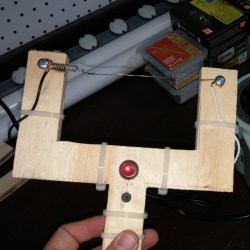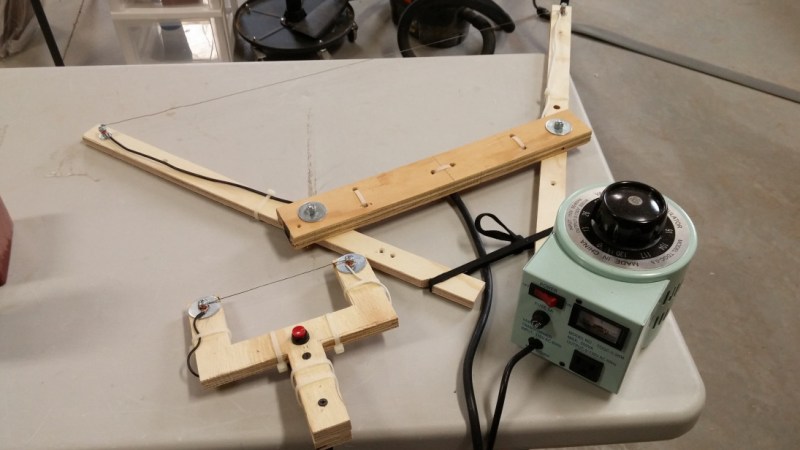One of [Bithead]’s passions is making Star Wars droids, and in the process of building the outer shell for one of them he decided to use hot wire foam cutting and make his own tools. Having the necessary parts on hand and having seen some YouTube videos demonstrating the technique, [Bithead] dove right in. Things didn’t go exactly to plan but happily he decided to share what did and didn’t work, and in the end the results were serviceable.
 [Bithead] built two hot wire cutters with nichrome wire. The first was small, but the second was larger and incorporated some design refinements. He also got an important safety reminder when he first powered on with his power supply turned up too high; the wire instantly turned red and snapped with an audible bang. He belatedly realized he was foolishly wearing neither gloves nor eye protection.
[Bithead] built two hot wire cutters with nichrome wire. The first was small, but the second was larger and incorporated some design refinements. He also got an important safety reminder when he first powered on with his power supply turned up too high; the wire instantly turned red and snapped with an audible bang. He belatedly realized he was foolishly wearing neither gloves nor eye protection.
When it came to use his self-made tools, one of the biggest discoveries was that not all foam is equal in the eyes of a hot wire cutter. This is one of those things that’s common knowledge to experienced people, but isn’t necessarily obvious to a newcomer. A hot wire cutter that made clean and effortless cuts in styrofoam did no such thing with the foam he was using to cast his droid’s outer shell. Still, he powered through it and got serviceable results. [Bithead]’s blog post may not have anything new to people who have worked with foam and hot wire cutters before, but if you’re new to such things you can use it to learn from his experiences. And speaking of improving experiences, [Bithead] most recently snazzed up the presentation of his R2-D2 build by getting tricky with how he hides his remote control.

















“One of [Bithead]’s passions is making Star Wars droids” amazingly original ! Genius !
Post bitching in “HackADay” amazingly original ! Genius !
Another potential future improvement could also be considering moving away from using a flammable material next to a hot wire?
Also, when cutting styrofoam with a hot wire, consider a respirator as well. Unless you have a fume hood.
Yeah, I was just wondering – how harmful can cutting styrofoam be? From what I just read, it doesn’t release cyanide, like some other foams would, but there’s some styrene and CO involved.
It’s an aromatic hydrocarbon. There are worse things to breathe in than the decomposition byproducts of Styrene but it’s generally a sooty flame that isn’t very “pure”. The CO can be an issue but that’s not really the primary concern.
http://fire.nist.gov/bfrlpubs/fire87/PDF/f87014.pdf
“In oxidative atmospheres, carbon monoxide (CO), carbon dioxide (C02) and oxidative hydrocarbons are formed.
Incapacitating effects observed during exposures to non-flaming effluents are not due to CO and C02 but rather to some other toxicant, probably the styrene monomer.”
Also, bear in mind that Styrene is not a single “thing”. It is comprised of multiple ingredients prior to thermal decomposition.
“Expandable polystyrene beads or foams may contain 3-7% of a volatile blowing agent (e.g. pentane) which is used in processing this product. Fire resistant polystyrenes usually contain halogenated additives and antimony oxide which are incorporated during polymerization.”
The hot wire is not isolated by that vari-auto-transformer from line input. Much better to use a beefy low voltage xfmr, even making the hot wire length the right length for a given fixed power supply.
But yeah, a gantry rail mounted knife like art framers use to cut a mat to surround the work within the frame is the way to go.
I second that. No isolation = .Very Dangerous!
Without galvanic isolation that nichrome wire is connected directly to the mains. Not to mention that nothing prevents the differential voltage from being turned up to a dangerous level.
I suspect he didn’t let the urethane foam cure properly. My guess is at least a week for a layer that thick. When fully dried out regular urethane foam cuts easily with a sharp blade or a saw.